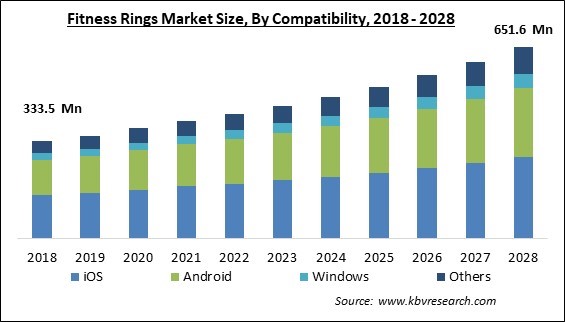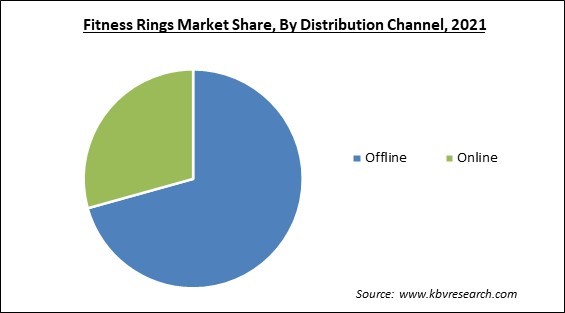The Global Fitness Rings Market size is expected to reach $651.6 Million by 2028, rising at a market growth of 7.3% CAGR during the forecast period.
Fitness rings are wearable devices that are designed to monitor and track data related to fitness and health. Most of the time, these items take the form of rings and are worn on the finger. They come outfitted with a wide variety of sensors and technology, enabling them to control and monitor various health and fitness factors. The market for fitness rings comprises many manufacturers and brands, some of which are well-established, while others are just newcomers in the world of technology.

In recent years, exercise or fitness rings have experienced a phenomenal rise in popularity within the fitness sector. Wearables like this keep tabs on a wide range of health and fitness metrics, such as the number of steps walked, the number of calories burnt, the heart rate, and the amount of quality sleep obtained. As awareness of health and well-being continues to rise, more people are turning to fitness rings to manage their fitness objectives and achievements.
These gadgets offer consumers a hassle-free and comfortable method of monitoring a variety of health and fitness indices, empowering them to make educated choices regarding their way of life. In addition, the quick speed of technical improvement has led to the development of increasingly complex fitness rings. As a result, these devices have recently received updates that include more functions and capabilities, like blood oxygen monitoring, sophisticated sleep tracking, and GPS tracking, to make the rings more helpful and appealing to customers.
There are currently a lot of fitness rings on the market that come with companion applications that enable users to synchronize their data with their smartphones as well as other devices. Because of this integration, users can readily access and evaluate their fitness data, as well as track their progress over time and establish new objectives.
COVID-19 impacted some enterprises and there is still uncertainty about customer demand and the economy, manufacturers produced new services and products to assist clients during the pandemic. Fitbit, for example, invested in research and development by cooperating with health industry giants such as Apple, Stanford Medical, as well as the Scripps Research Institute to examine how data from wearables might diagnose and track infectious diseases such as COVID-19. As many studies during this period pointed at the factors like obesity that may increase the severity of COVID-19 infection, most individuals invested in health trackers. Therefore, the pandemic had a positive impact on the fitness rings market.
Fitness tracking is more practical for customers by connecting fitness rings with other gadgets. Fitness data tracking and analysis are now made simpler by the fitness ring's sensors and algorithms syncing with sensors on mobile phones and other devices. Fitness tracking is more effective with this increased accuracy, which raises the demand for fitness rings even more. Some fitness rings can be used to gauge a user's stress level using electrodermal activity (EDA), the same concept used in lie detector tests to gauge emotion and mental state through the skin. Some manufacturers are also incorporating payment features into the fitness rings. As a result, the demand for fitness rings is rising, propelling the growth of the market.
The demand for fitness rings has been significantly increased by the movement toward data-driven fitness. With the advancement of technology, people are placing more and more emphasis on using data to monitor their fitness development and decide what kind of physical activity to engage in. Fitness rings provide a simple and practical way to gather and analyze fitness statistics, making them a desirable alternative for people trying to maximize their routines. Data-driven fitness trends encourage consumers to track their progress, create objectives, and modify their exercise routines for the best outcomes. Therefore, as the demand for data-driven fitness increases, it will expedite the expansion of the fitness rings market.
Much of the information gathered by fitness tracking devices is personal information about the user, including weight, birth date, photographs, GPS coordinates, social media data, steps, heart rate, and background information needed by the device. Most of this data is provided to the companion apps of fitness rings by themselves. The main worry is data theft rather than extremely personal data. The features of connectivity that enhance the user's experience may also lead to data leaks. The individual is vulnerable to potentially detrimental invasions of privacy as a result of this. The market expansion is expected to be hampered during the forecast period.
Based on compatibility, the fitness rings market is categorized into iOS, android, windows, and others. The android segment procured a considerable growth rate in the fitness rings market in 2021. This is due to the platform's growing popularity, especially in emerging economies. Since they are not label-specific operating software, android-based fitness rings are becoming more popular. Android is used by the majority of cell phone brands in developed countries. Furthermore, smartphone use is expanding due to higher disposable income, and fitness tracker usage is expected to follow suit.
On the basis of distribution channel, the fitness rings market is divided into online and offline. The offline segment acquired the largest revenue share in the fitness rings market in 2021. The fact that a significant percentage of consumers desire to sample the product and receive advice before purchasing is a significant driver for the offline segment. Despite the presence of alternate distribution channels, many of the biggest fitness tracker ring firms are selling products through offline channels to build traction among potential customers.

| Report Attribute | Details |
|---|---|
| Market size value in 2021 | USD 401.8 Million |
| Market size forecast in 2028 | USD 651.6 Million |
| Base Year | 2021 |
| Historical Period | 2018 to 2020 |
| Forecast Period | 2022 to 2028 |
| Revenue Growth Rate | CAGR of 7.3% from 2022 to 2028 |
| Number of Pages | 133 |
| Number of Table | 257 |
| Report coverage | Market Trends, Revenue Estimation and Forecast, Segmentation Analysis, Regional and Country Breakdown, Companies Strategic Developments, Company Profiling |
| Segments covered | Distribution Channel, Type, Region |
| Country scope | US, Canada, Mexico, Germany, UK, France, Russia, Spain, Italy, China, Japan, India, South Korea, Singapore, Malaysia, Brazil, Argentina, UAE, Saudi Arabia, South Africa, Nigeria |
| Growth Drivers |
|
| Restraints |
|
Region wise, the fitness rings market is analyzed across North America, Europe, Asia Pacific, and LAMEA. The North America segment witnessed the maximum revenue share in the fitness rings market in 2021. The United States is the major innovation center for the fitness tracker business, with significant players. According to the American College of Sports Medicine's survey, wearable technology is the most popular fitness trend. With the success of fitness rings and Apple operating system-based smartphones in this region, well-known businesses are developing fitness rings.
Free Valuable Insights: Global Fitness Rings Market size to reach USD 651.6 Million by 2028
The market research report covers the analysis of key stake holders of the market. Key companies profiled in the report include Ultrahuman Healthcare Private Limited, Sky Labs, Oura Health Oy, ArcX Technology Ltd, SLEEPON, Circular and Ringly Inc.
By Distribution Channel
By Compatibility
By Geography
The global Fitness Rings Market size is expected to reach $651.6 Million by 2028.
Growing technological advancements in fitness rings are driving the market in coming years, however, Growing worries about safety and privacy restraints the growth of the market.
Ultrahuman Healthcare Private Limited, Sky Labs, Oura Health Oy, ArcX Technology Ltd, SLEEPON, Circular and Ringly Inc.
The iOS segment acquired maximum revenue share in the Global Fitness Rings Market by Compatibility in 2021 thereby, achieving a market value of $276.6 Million by 2028.
The North America market dominated the Global Fitness Rings Market by Region in 2021 and would continue to be a dominant market till 2028; thereby, achieving a market value of $261 Million by 2028.
Our team of dedicated experts can provide you with attractive expansion opportunities for your business.

